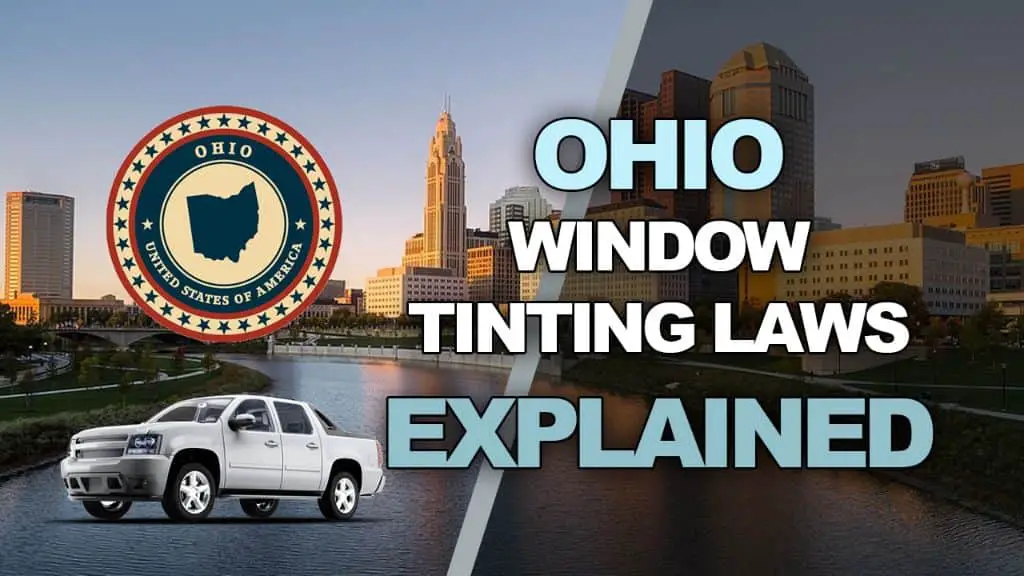

Article Created by Ryan Pietrzak
Last updated on February 14, 2024Ohio Tint Laws – 2024 Updated Legal Tint Limit
Please note that Ohio Tint Laws Regulation can change daily and may be interpreted differently at the city or county level. We recommend verifying this information with your local DMV or law enforcement agencies. We have manually fact-checked this content using official state resources. Ohio enacted tinting laws in 2004. If any information provided is incorrect or outdated, please contact us so we can make the necessary corrections. Thank you.
2024 Ohio Tint Laws – Legal Tint Limit For Passenger Vehicles
- Front Windshield: Non-reflective tint is allowed on the top 5 inches of the windshield.
- Front seat side windows: up to 50% tint darkness allowed. Front side windows must allow at least 50% light transmission, restricting tint to 50% or lighter.
- Back seat side windows: Any tint darkness can be used
- Rear window: Any tint darkness can be used
2024 Ohio Tint Laws – Legal Tint Limit For Multi-Purpose Vehicles
- Front Windshield: Non-reflective tint is allowed on the top 5 inches of the windshield.
- Front seat side windows: up to 50% tint darkness allowed
- Back seat side windows: Any tint darkness can be used
- Rear window: Any tint darkness can be used

- Medical exemptions: Ohio tint laws permit darker tints on front side windows with a doctor’s note
- Ohio tint laws prohibit metallic or reflective tint on any of the windows
- Ohio tint laws are statewide with no additional local regulations
- Violating Ohio tint laws can result in fines around $150 for a first offense.
What does VLT Mean according to Ohio Tint Laws?
- Window tint film’s light transmission is measured as VLT (Visible Light Transmission) and each state has its own legal limits for VLT on car windows.
- A HIGHER VLT means that more light is allowed to pass through the window tint film.
- Example: a 75% tint will allow 75% of the light to pass through whereas a 5% tint will only allow 5% of the light to pass through, making the 5% tint a much darker film.
- Ohio window tint laws has specific VLT limits for Passenger Vehicles and Multi-Purpose Vehicles.
FAQ’s Regarding Ohio Tint Laws and Ohio Legal Tint Limit
What is the darkest legal tint in Ohio?
In Ohio, the darkest legal tint for the front side windows and the windshield is 50% light transmission, meaning the tint must allow at least 50% of the light to pass through. The back side windows and the rear window can have any darkness of tint.
Are police exempt from window tint laws in Ohio?
In Ohio, police vehicles are exempt from the window tint laws that apply to private vehicles. This exemption allows law enforcement vehicles to have darker window tints for operational reasons, such as privacy and security.
How do I get a tint waiver in Ohio?
To obtain a tint waiver in Ohio, you must have a certified medical condition that necessitates darker window tints for protection from sunlight or bright artificial light. The process involves submitting a form completed by a licensed physician to the Ohio Bureau of Motor Vehicles, stating the medical necessity for the darker tint.
How much is a tint ticket in Ohio?
The cost of a tint ticket in Ohio can vary based on the locality and the discretion of the court, but typically the fine ranges from $100 to $200. Repeat offenses or failure to comply with a fix-it ticket can result in higher fines.
Can you get pulled over for tint in Ohio?
Yes, in Ohio, you can be pulled over by law enforcement if your vehicle’s window tint is suspected of being darker than what state law permits. The police have the authority to use tint meters to measure the light transmittance of your vehicle’s windows during the traffic stop.
How to get a Tint Exemption in Ohio
The State of Ohio does not currently allow for window tint medical exemptions that would allow you to tint your windows darker for medical purposes. If you would like to file a petition with the State in order to appeal this and request that they change the law we suggest you contact the Ohio State Representative directly.

Ryan Pietrzak
Creator of Windowtintlaws.us

